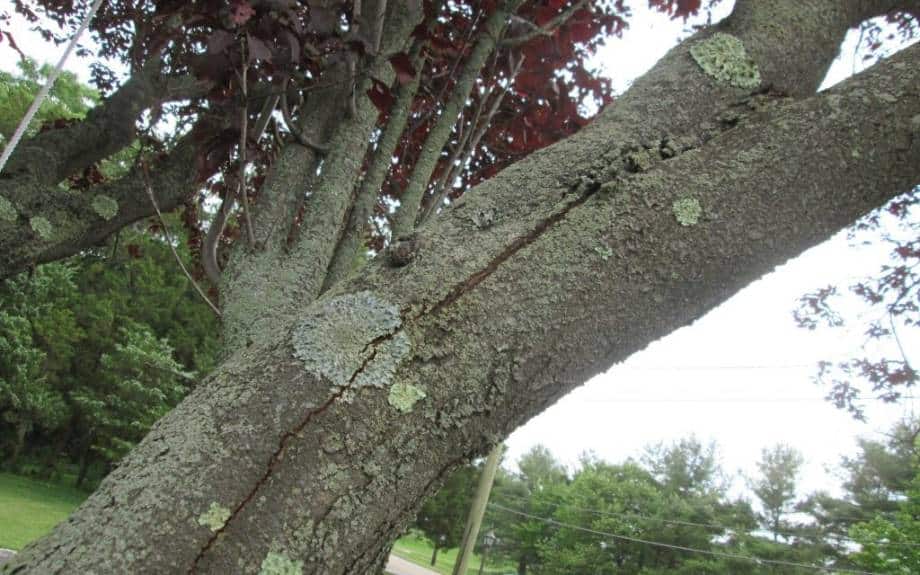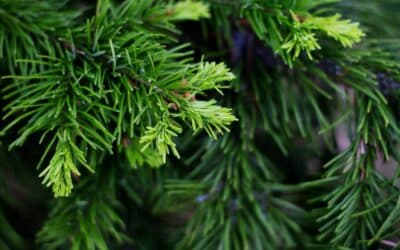Blog Topics
Ever noticed those eerie, vertical scars on your trees come winter’s end? Those are frost cracks, a silent enemy of our Northern Virginia trees. They’re not just chilling reminders of winter’s harshness but can signal serious health risks for your leafy friends.
Fasten your seatbelts, tree lovers, as we delve into the causes, impacts, and prevention of this winter phenomenon.
Frost Cracks – Key Takeaways
- Frost cracks are vertical splits in tree bark caused by sudden temperature changes and can lead to disease, decay, and weakened structural integrity.
- Rapid temperature changes and daily contraction and expansion of wood are the main causes of frost cracks.
- Frost cracks can have a negative impact on plant health, making trees more vulnerable to pests and diseases, hindering water and nutrient transport, and stunting growth.
- Frost cracks pose risks to property and safety, as weakened trees can break during high winds or heavy snowfall, causing property damage and safety hazards.
Understanding the Phenomenon of Winter Tree Damage
It’s essential to understand the phenomenon of winter tree damage, especially if you’re living in Northern Virginia. The extreme cold can wreak havoc on the well-being of your trees.
One such form of winter tree damage is frost cracks. Frost cracks are vertical splits in the bark of a tree, typically caused by sudden temperature changes. On a frigid night, the outer layer of a tree can freeze while the inside stays warm. When the temperature plummets dramatically, the outer layer of the tree contracts faster than the inside, causing the bark to split open.
Frost cracks can cause significant harm to your trees. They allow pathogens to enter, which can potentially lead to disease and decay. Moreover, frost cracks can weaken the structural integrity of your tree, making it more susceptible to wind damage and other environmental stresses.
It’s crucial to regularly check your trees for any signs of frost cracks during the winter months and take necessary actions to prevent them from further damage. Prevention and early detection can save your trees from irreparable damage. It’s all about understanding the problem and taking proactive steps.
Causes and Identification of Vertical Frost Cracks
Vertical splits, often caused by rapid temperature changes, can be a telltale sign of distress in your leafy giants. These fissures, commonly known as frost cracks, can wreak havoc on your Northern Virginia trees if left unchecked. Recognizing the symptoms and causes can help you take swift action to protect your arboreal treasures.
The process usually starts with a small wound or blemish on the tree. During winter, the daily temperature fluctuation results in the wood contracting and expanding. This repeated stress can worsen the injury, leading to a full-blown frost crack. To identify frost cracks, look for these four signs:
- Large, vertical splits in the tree trunk.
- Darkened or wet appearance around the crack.
- Exposed inner wood or sap seeping out.
- Audible cracking sounds during severe cold snaps.
Ignoring frost cracks can lead to serious repercussions. They provide an entryway for pests and diseases, which can further weaken your trees. Over time, this can lead to structural instability, and in severe cases, tree death. So, when you spot a frost crack, don’t delay! Consult with a tree care professional to discuss the best course of action. Remember, a stitch in time saves nine, especially when it comes to tree health.

Potential Impact on Plant Health
Unchecked vertical splits can significantly impact the health of your green giants, making them more susceptible to pests and diseases. These cracks serve as an open invitation for insects to burrow into the tree’s tissues, potentially causing severe damage from the inside out. In addition, the exposed inner wood may be a fertile ground for the growth of harmful fungi and bacteria.
Moreover, frost cracks can also weaken the overall structural integrity of your trees. This means they’re more likely to break during high winds or heavy snowfall. It’s not just about the health of your trees though. Weakened trees can also pose a significant risk to your property and your family’s safety.
On top of all these, frost cracks can hinder the tree’s ability to transport water and nutrients. This can stunt its growth and even lead to its premature death. Therefore, it’s crucial to address frost cracks as soon as you notice them.
To keep your Northern Virginia trees healthy and thriving, make sure you’re vigilant about spotting and treating frost cracks. Remember, your trees aren’t just part of your landscape–they’re part of your home.
Strategies for Tree Care and Protection
To ensure the health and longevity of the green giants in your landscape, there are several strategies you can employ for their care and protection.
First off, regular inspections are key. You should look out for signs of frost cracks during the winter months. These are vertical splits in the tree trunk that occur due to temperature fluctuations.
By properly mulching your trees, you’re providing them with an extra layer of protection against the cold. A layer of organic mulch around the base of the tree can help maintain soil temperature and moisture levels. It’s also recommended to water your trees thoroughly in the fall before the first hard freeze. This helps to ensure they’re hydrated enough to combat the negative effects of the frost.
Another strategy is to wrap the trunks of younger trees or those with thin bark. Tree wrap can provide a physical barrier against the cold, reducing the risk of frost cracks.
While frost cracks aren’t necessarily fatal to trees, they can make them more susceptible to disease and insect infestations. So, protect your leafy friends with these strategies and they’ll thank you by standing tall and healthy for many years to come. And remember, when in doubt, hiring a professional service can take a lot of the guesswork out of keeping your trees safe.
Frost Cracks – Frequently Asked Questions
What specific types of trees in Northern Virginia are most prone to frost cracks?
In Northern Virginia, deciduous trees like maples, oaks, and elms are particularly prone to frost cracks. Cold winter temperatures can cause their trunks to contract and split, leading to these damaging cracks.
How does the age of a tree affect its susceptibility to frost cracks?
Older trees are more susceptible to frost cracks. Their bark becomes thicker and less flexible over time, which makes it harder for them to expand and contract with temperature changes, leading to potential cracking.
Are there any warning signs of frost cracks before they appear?
Over 30% of trees in cold climates suffer frost cracks. Warning signs are difficult to spot, but you might notice a dark, wet area on the bark during a thaw, indicating a possible crack.
What is the best time of the year to check for and treat frost cracks?
The ideal time to check for and treat frost cracks is late winter or early spring. This is when the temperature fluctuations that cause them are most prevalent, and treatment can be most effective.
Can frost cracks impact the surrounding environment or other plant species?
Imagine your lush garden threatened! Yes, frost cracks can affect the surrounding environment. Damaged trees weaken, becoming susceptible to pests and disease, potentially spreading to other plant species and disrupting the ecosystem balance.
Are Your Virginia Trees Cracked?
Call Riverbend Tree Service today at 703-402-9366. We’re your Northern Virginia tree health management experts, and you can rely on our experience and skill to keep your trees and landscaping healthy all year!
Proudly serving Northern Virginia and the Washington D.C. area.
Give Us a Call at 703-402-9366
If you'd like help with your trees or landscape, have any questions, or would like to schedule an appointment with one of our Certified Arborists, please give us a call. We'd love to hear from you!



